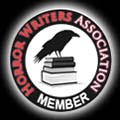I love these posts because the authors have not only opened up to you about themselves, their inspiration, and their writing, but they have also given you some wonderful book talking points to hand sell these titles.
Today it is Brian W. Matthews.
***************************************************************
Somewhere in the middle of nowhere, where longitude misses latitude by a narrow but vital margin, and where the air crackles with complex energies, a narrow dirt path runs the length of the world, unfolding like a long black tongue.
Along this path we walk hand-in-hand, under the fractal shadows of ancient trees just starting to lose their leaves. It stretches on and on, cluttered with small, dry bones and ghostly spider webs. For the month is October, Halloween is rapidly approaching, and the supernatural rules supreme.
I’ve always loved this time of year. As a child, I looked forward to Halloween, even more so than Christmas, because Halloween was when the television stations rolled out their stock of horror films. As much as I enjoyed the classic Universal monsters—Dracula, Frankenstein, the Mummy—I preferred William Castle’s movies, particularly those starring the incredible Vincent Price. I still remember sitting on the edge of the sofa, legs crossed, hands stuffed in my mouth, as Mr. Price fought an incredibly silly looking creature in The Tingler, or how he terrorized a houseful of unsuspecting guests in The House on Haunted Hill. What I enjoyed most about these movies, I think, was that they didn’t contain the traditional horror monsters—vampires, werewolves, ghosts. They looked beyond those tropes (old even back in the 1950s) to create new terrors, ones the public hadn’t seen. And because the public hadn’t seen them, because they hadn’t any experience with them, they didn’t know what to expect. These films created a whole new category of monsters to fear.
Then later, when I was a bit older, something wonderful happened: an uncle gave me a copy of James Herbert’s The Fog, a novel about a mysterious crack in the earth from which an eerie fog seeps, one that causes insanity in anyone who come into contact with it. I read it in two days. The story horrified me, and by the time I’d finished it, I was hooked.
Horror movies were cool, but horror books were magic. And I knew where to find more of that magic.
The library.
I began checking out books: Shirley Jackson’s classic The Haunting of Hill House, Richard Matheson’s homage to the former, Hell House, Ira Levin’s Rosemary’s Baby, a novel whose influence can be felt in my latest novel, The Conveyance. I loved how they frightened me and entertained me at the same time. I couldn’t get enough of them. These authors made up what I call the first Golden Age of horror writing.
Soon afterward, I discovered a new clutch of horror authors, and that discovery ultimately changed my life. (So much so that if I hadn’t, you wouldn’t be reading this.)
These newcomers, who could conceivably be called the old guard now, brought horror to the forefront of genre fiction: Stephen King, Clive Barker, Anne Rice, Dean Koontz, Robert McCammon, Richard Laymon, Ramsey Campbell. The list goes on. They inspired. They frightened. They brought terror into our backyards. They heralded, for me, the second Golden Age of horror writing.
While each influenced me in small ways, I have to say that Clive Barker influenced me the most, followed closely by Stephen King. Barker prefers to create non-traditional horrors such as the Cenobites of his Hellbound Heart novella (and later in his Hellraiser movies) or Dr. Philip Decker, the lunatic murderer in Cabal. Then there is Mr. Hood, the mysterious warden of Holiday House in his children’s fairytale, The Thief of Always. Barker’s horrors have a more human element, often rising from the human condition, an approach I found compelling. King, on the other hand, approaches his novels in themes, over which he constructs solid stories, brick by bloody brick. Some of his best works touch on the broad themes that affect all of us, like the rise of peer pressure and the dangers it presents to the more fragile of our youth—Carrie; America’s infatuation with celebrity, sometimes bordering on psychotic obsession—Misery; and more recently, the unhealthy preoccupation the iGeneration has with its electronic gadgets—End of Watch.
I strive to blend these approaches in my own writing, which began with two short stories that appeared in the science fiction anthology, Foreshadows: The Ghosts of Zero. “Lament,” the first story I wrote for the collection, concerns itself with the consequences of behavior, and my belief that good deeds are rewarded, while evils are, at some point, always returned tenfold. The second story, “Graveduggery” (co-authored with fellow author, Jeff LaSala), had a predetermined plot, so I couldn’t control the theme, but it does contain what I feel is my best writing from those early years—a sequence that takes place in a fictional Nazi concentration camp in Poland. It was this piece that convinced me to reach for the brass ring and write a novel.
Released in 2012 by JournalStone, my debut novel, Forever Man, explored the theme of racism, and how preconceived notions about a person’s color can have disastrous consequences. In addition to this deeper theme, the story has the requisite-but-nontraditional monster, called a Fek, along with the associated carnage. But the creature isn’t the central plot point of the story. Rather, it is the human interaction and reaction to racism, it is a mother’s fear for her kidnapped child, and it is how a small group of innocents can ultimately defeat overwhelming evil that drives the story.
Revelation, the second book in the Forever Man series, addressed the recent surge in religious intolerance and how fanatical devotion to any one thought or belief can be perilous. Also filled with unusual creatures (including a nasty bit of fiction called the Cybell), Revelation also addressed a theme I would more fully explore in my next novel: child abuse.
To me, horror is much more than the ghostly bump in the night, or the muffled thump of a heartbeat coming from within a wall, or the creak of a footstep on the stairs when no one else is supposed to be home. Real horror, the kind that makes you squirm and want to close the book, is often about how people treat one another, the evils we can inflict on another human being, more often than not someone who is weaker, like a child. During my years as a child therapist, I saw too much of this abuse from an uncomfortably close perspective.
Which brings me to my latest work, The Conveyance. Couched in a creepy, small town setting, this was my boldest attempt to date to weave a story that blended mainstream fiction with the horror genre. In fact, the first third or so of the novel contains no outright horror, just a slow building of suspense as you learn about the characters and their strengths and weaknesses, along with the occasional hint about trouble simmering just beneath the surface of life’s pedestrian normality. As the story progresses, there is blood and loss and death, but the real horrors, the brutal twist-the-knife-in-your-gut moments, center around child abuse and the hazards of toxic love. While I am proud of all my works, this is the one of which I am proudest.
And that, ladies and gentlemen, is my tale. It has taken some time to tell, and we are nearing the end of this dark, desolate path. Fear not, for more horrors lurk on the horizon, tales told by what I am calling the third Golden Age of horror writing, tales told by the likes of Joe Hill and Jonathan Maberry and Sarah Pinborough and Caitlín R. Kiernan. Tales told by a wave of talented newcomers like Josh Malerman and Paul Temblay and, if you will pardon this moment of hubris, Yours Truly. If you haven’t heard of these people, visit your local library and look them up. Their stories will keep you awake, night after night.
I promise.
BIO: By day, Brian W. Matthews works as a financial planner, but after the sun goes down—in the deep dark of night—he scribes stories meant to entertain and, perhaps, terrify. When he isn’t developing investment portfolios or crafting tales of monsters and madmen, he tries valiantly to knock a little white ball over the rolling green hills of a golf course without hitting traps or trees. He can also be found lurking in the wilds of Michigan’s Upper Peninsula, hunting and fishing and generally causing mayhem. Brian lives in southeast Michigan with his wife, daughter, and two step-daughters.
Use these links to learn more about Brian W. Matthews:





No comments:
Post a Comment